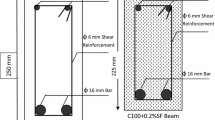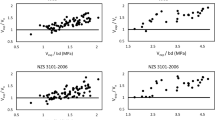Abstract
Design procedures for corbels are given in various Codes of Practice e.g. ACI 318-89 [1]. These codes give equations based on research on corbels made with normal strength concrete. Consequently, they tend to limit the value of concrete strength to be used in these equations. This will result in an underestimation of the load carrying capacity of corbels made with high strength concrete (HSC) as will be shown later.
In the present paper, a semi-empirical equation for the design of corbels made with high strength concrete is derived. In the derivation, an empirical factor K is used, the value of which was determined from experimental data based on thirty tests made by Fosteret al. [2]. This factor is assumed to be dependent on the shear span/effective depth ratio a/d. The expression found for K was then used to calculate the theoretical load carrying capacity of corbels made with high strength concrete. Twelve more tests were carried out, in-house, on corbels made with high strength concrete and the experimental results were compared with the theoretical values based on K as obtained from the empirical expression. It was found that the expression for K resulted in good correlation between theoretical and experimental values for the load carrying capacity of corbels made with high strength concrete. Comparison of the ACI Code values was made with both experimental and theoretical data and it was found the Code greatly underestimates the load capacity of corbels made with high strength concrete.
Résumé
Les méthodes de dimensionnement des corbeaux sont données dans diverses spécifications comme le Code ACI 318-89 [1]. Ces normes donnent des équations basées sur la recherche en corbeaux fabriqués en béton de résistance normale. En conséquence, ces équations ont tendance à limiter la résistance de béton à utiliser. Ceci mènera à sous estimer la capacité de support des corbeaux fabriqués en béton de haute résistance comme cela va être démontré plus tard.
Le présent article démontre la dérivatïon d'une équation semi empirique pour le dimensionnement des corbeaux en béton de haute résistance. Un facteur empirique K est utilisé dans la dérivation, pour lequel la valeur a été déterminée expérimentalement à partir des résultats de trente essais effectués par Fosteret al. [2]. Ce facteur est présumé être dépendant sur le rapport porté de glissement: retombée effective. L'expression dérivée pour le facteur K a été utilisée pour calculer la capacité de support théorique des corbeaux en béton de haute résistance. Les auteurs ont effectué une série de douze essais sur des corbeaux fabriqués en béton de haute résistance et les résultats obtenus ont été comparés aux valeurs théoriques basées sur K comme étant dérivé à partir de l'équation empirique.
La comparaison a démontré que l'équation de K a mené à une bonne corrélation entre les résultats théoriques et ceux expérimentaux pour les valeurs de capacité de support des corbeaux fabriqués en béton de haute résistance.
La comparaison entre les valeurs du Code ACI et les résultats théoriques ainsi qu'expérimentaux a démontré que le Code sous-estime la capacité de charge des corbeaux en béton de haute résistance.
Similar content being viewed by others
References
ACI Committee 318 ‘Building Code requirements for Reinforced Concrete’ (ACI 318-89), American Concrete Institute, Detroit, 1989.
Foster, S. J., Powell, R. E. and Selim, H. S., ‘Performance of high strength concrete corbels’,ACI Structural Journal 93 (5) (September–October 1996) 555–563.
Saafi, M. and Toutanji, H., ‘Design of high performance concrete corbels’,Mater. Struct.,31 (November 1998) 616–622.
Mangat, P. S. and Halabi, W., ‘Steel fibre reinforced high strength concrete corbels: Test results and analysis’,The Structural Eingineer 74 (23&24) (10 Dec. 1996) 412–422.
Mau, S. T. and Hsu, T. T. C., ‘Shear strength prediction for deep beams with web reinforcement’,ACI Structural Journal (November–December, 1987), 513–523.
Ahmad, S. H. and Shah, S. P., ‘Properties of high strength concrete for structural design’,Mat. Res. Soc. Symp., Proc. 42 (1985) 169–181.
Neville, A. M., ‘General relation for strengths of concrete specimens of different shape and sizes’,ACI Journal, Proc. 63 (10) (October 1966) 1095–1109.
Author information
Authors and Affiliations
Rights and permissions
About this article
Cite this article
Al-Shawi, F.A.N., Mangat, P.S. & Halabi, W. A simplified design approach to corbels made with high strength concrete. Mat. Struct. 32, 579–583 (1999). https://doi.org/10.1007/BF02480492
Received:
Accepted:
Issue Date:
DOI: https://doi.org/10.1007/BF02480492




